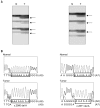Mutational analysis of TTK gene in gastric and colorectal cancers with microsatellite instability
- PMID: 20057968
- PMCID: PMC2802850
- DOI: 10.4143/crt.2009.41.4.224
Mutational analysis of TTK gene in gastric and colorectal cancers with microsatellite instability
Abstract
Purpose: The TTK gene plays a crucial role in regulation of the mitotic checkpoint. The TTK gene has an A9 mononucleotide repeat in the coding sequences, which harbors mutations in gastric (GC) and colorectal cancers (CRC) with microsatellite instability (MSI). However, there are three more repeats (the A7s) in the coding sequences that have not been analyzed. The aim of this study was to explore whether the three A7s as well as the A9 are altered in GC and CRC, and to find any association of TTK mutation with clinocopathologic characteristics of GC and CRC.
Materials and methods: We analyzed exon 5 (A7 and A7) and exon 22 (A9 and A7) which have repeat sequences in 30 GC with high MSI (MSI-H), 15 GC with low MSI (MSI-L), 35 CRC with MSI-H, and 15 CRC with MSI-L, by single-strand conformation polymorphism (SSCP) and DNA sequencing assays.
Results: Overall, we detected 23 frameshift mutations in the repeat sequences of TTK in the GC with MSI-H (11/30; 36.7%) and the CRC with MSI-H (12/35; 34.3%), but not in the cancers with MSI-L. The mutations were observed in both A9 and A7 of exon 22, but in neither of the two A7s of exon 5. The mutations consisted of c.2560delA, c.2560dupA, c.2571delA and c.[2560delA(+)2571delA]. All of the mutations were frameshift mutations and would result in premature stops of TTK protein synthesis. There was no significant difference in clinopathologic parameters of the cancers with the mutations.
Conclusion: Our data indicate that frameshift mutations of TTK are common in both GC and CRC with MSI-H, and that the mutations occur not only in the A9 repeat but also in the A7 repeat. The data suggest that frameshift mutations of TTK might alter cell cycle control in the affected cells and contribute to pathogenesis of cancers with MSI-H.
Keywords: Colorectal neoplasms; Gastric neoplasms; Microsatellite instability; Mutation; TTK.
Figures

References
-
- Grady WM. Genomic instability and colon cancer. Cancer Metastasis Rev. 2004;23:11–27. - PubMed
-
- Gorringe KL, Chin SF, Pharoah P, Staines JM, Oliveira C, Edwards PA, et al. Evidence that both genetic instability and selection contribute to the accumulation of chromosome alterations in cancer. Carcinogenesis. 2005;26:923–930. - PubMed
-
- Imai K, Yamamoto H. Carcinogenesis and microsatellite instability: the interrelationship between genetics and epigenetics. Carcinogenesis. 2008;29:673–680. - PubMed
-
- Markowitz S, Wang J, Myeroff L, Parsons R, Sun L, Lutterbaugh J, et al. Inactivation of the type II TGF-beta receptor in colon cancer cells with microsatellite instability. Science. 1995;268:1336–1338. - PubMed
-
- Rampino N, Yamamoto H, Ionov Y, Li Y, Sawai H, Reed JC, et al. Somatic frameshift mutations in the BAX gene in colon cancers of the microsatellite mutator phenotype. Science. 1997;275:967–969. - PubMed
LinkOut - more resources
Full Text Sources
Miscellaneous

